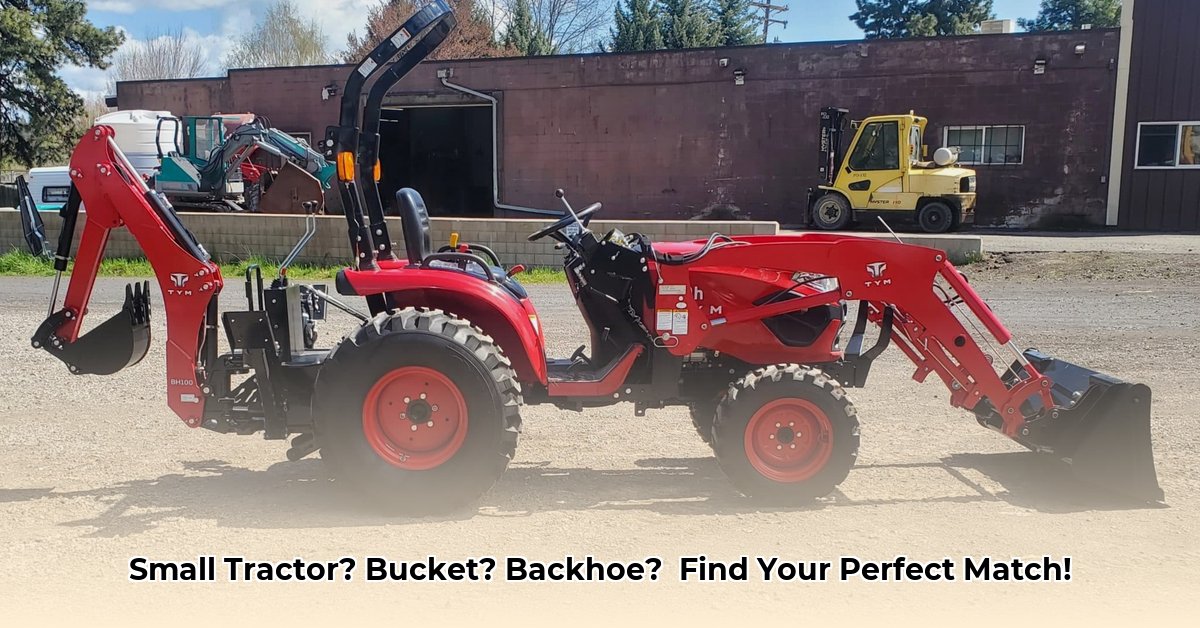
Choosing the right compact tractor can be a daunting task. This comprehensive guide walks you through the process, helping you select a machine that meets your needs, fits your budget, and promotes sustainable farming practices. We'll cover everything from assessing your farm's requirements to comparing models and understanding long-term costs. For more information on tractors with backhoes, check out this helpful resource: Tractor Backhoe Guide.
1. Assessing Your Needs: Matching Tractor to Task
Before considering horsepower or transmissions, define your farming operation. What’s the size of your property? What tasks will the tractor handle—tilling, hauling, mowing, digging fence post holes with a backhoe? What types of soil do you have? Clay soil requires more power for tilling than sandy loam. Knowing this helps determine your horsepower needs and essential attachments. Don't forget your budget – it's a crucial constraint.
2. Decoding Tractor Features: What Matters Most?
Several key features significantly impact a tractor's performance and suitability.
Horsepower (HP): This represents the tractor's power. More HP means more power for demanding tasks. The more land you work, the more HP you’ll likely need. A larger acreage generally necessitates a higher horsepower rating.
Power Take-Off (PTO): The PTO is a power outlet for attachments like tillers and mowers. It enhances versatility and avoids the need for separate equipment.
Transmission: The transmission is the tractor's gearbox. Hydrostatic transmissions offer smoother operation but may be less fuel-efficient than manual transmissions in certain conditions. Manual transmissions often provide better fuel economy but require more operator skill. The best choice depends on your preference and operational needs.
Backhoe Specifications: Consider reach (horizontal extension), lift capacity (weight it can handle), and digging depth. These specs determine the backhoe's capabilities and should align with your intended tasks. Do you need to dig deep post holes or wide trenches? This will impact the backhoe's required specifications.
3. Compact Tractor Models Overview: A Comparative Analysis
The following table compares popular compact tractor models. Note: Fuel efficiency and maintenance costs vary and heavily depend on usage patterns. These figures require additional research and may vary by location and dealer.
| Model | Horsepower | PTO HP | Transmission | Backhoe Specs (Check Manufacturer) | Estimated Price Range |
|---|---|---|---|---|---|
| Kubota B26 TLB | 26 | 22 | Hydrostatic | (Check Manufacturer Specs) | (Check Dealer Pricing) |
| Massey Ferguson GC1725M | 25 | 20 | Hydrostatic | (Check Manufacturer Specs) | (Check Dealer Pricing) |
| New Holland Workmaster 25S | 25 | 19 | Manual | (Check Manufacturer Specs) | (Check Dealer Pricing) |
| John Deere 2025R TLB | 24 | 18 | Hydrostatic | (Check Manufacturer Specs) | (Check Dealer Pricing) |
Remember: Specifications are approximate. Always verify with the manufacturer or a dealer for precise details. Fuel efficiency and annual maintenance costs are significant variables impacted by usage and maintenance practices. Further research is crucial to make informed decisions.
4. Making Your Decision: A Step-by-Step Guide
Prioritize Your Needs: List your tasks in order of importance. What are your absolute requirements?
Match Specs to Needs: Select tractors meeting or exceeding your minimum requirements for HP, PTO, and backhoe features. Avoid compromises that could affect long-term efficiency.
Get Quotes: Contact multiple dealers for accurate pricing and financing options. Shop around for the best deals.
Explore Financing: Consider financing options such as loans or leasing to manage your investment costs effectively.
Test Drive (If Possible): If possible, test-drive a few models to experience their handling and operation.
5. Long-Term Considerations: Beyond the Purchase
Owning a tractor is a significant long-term commitment. Account for:
Insurance: Protect your investment with appropriate insurance coverage.
Maintenance: Regular maintenance extends the tractor's lifespan and prevents costly repairs.
Regulatory Compliance: Understand your local regulations on equipment operation and maintenance.
These ongoing costs are essential considerations when budgeting.
6. Resources for Further Research
Your local agricultural extension office is an invaluable resource. They offer personalized advice and connect you with experts. Manufacturer websites provide detailed specifications and dealer locations. Online forums and agricultural publications offer insights from experienced tractor owners.
This guide empowers you to choose the right compact tractor for your needs. Thorough research and planning are key to making this important investment. Happy farming!